 Below is the written transcript of my YouTube tutorial video Converting Fischer to Hayworth Pyaranose and Furanose.
Below is the written transcript of my YouTube tutorial video Converting Fischer to Hayworth Pyaranose and Furanose.
If you prefer to watch it, see Video HERE, or catch the entire Fischer Projections Tutorial Series.
(click here to see the video on YouTube)
[Start of Transcript]
Leah here from leah4sci.com/MCAT, and in this video, I'm going to show you how to convert a sugar in a Fischer Projection to a Haworth Projection and a Chair Confirmation. You can find my entire series on Fischer Projection alongwith my practice quiz and cheat sheet by visiting my website at leah4sci.com/Fischer.
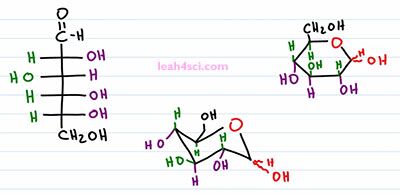
Knowing how to convert between Fischer, Haworth and Chairs is a critical skill for the MCAT not just the drawing but actually recognizing how the structure should look when you convert it so that you don't have to waste any time during the actual drawing on your exam. But to learn how to recognize it, you actually have to take the time and learn how to draw it, learn the patterns to look out for and then you can use the shortcut to save time.
Let's start with the Fischer Projection for D-glucose. Recognize that D-glucose is ad aldohexose which means it has an aldehyde at the end, it has 6 carbons and the ose means sugar. The trick for recognizing glucose especially D is that you simply alternate right, left, right, left and then D means that it goes on the right. So we have an OH on the right, an OH on the left, an OH on the right and then an OH on the right for the D, L is on the left and then everything is reverse for L. I'm purposely keeping the colors different for the right and the left because that will be the key behind the trick, say I want you to be able to differentiate the groups. And the final carbon is just a CH2OH. Carbons 1 and 6 are 8 chiral so they're not written out in the Fischer Projection form, but carbons 2 through 5 are and that's why we have it drawn out this way. Since aldehyde is higher priority, we start counting from the top. And without going through the complete reaction I want you to simply recognize that to convert between the Fischer or linear form to the Haworth or cyclic form, the OH on carbon 5 is the one that attacks. So the OH will attack the Carbonyl carbon, kick off the bond between carbon and oxygen making that an O which gets protonated to an OH. And the OH that forms can be facing forward or rear and that's because the aldehyde has an Sp2 hybridized carbon and if it's from one side, you get the Alpha, if it gets attack from the other side, you get the beta but the reaction is still the same and for the trick it doesn't matter which one you want to use.
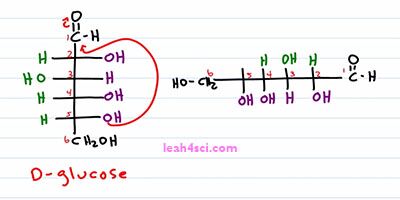
Let's look at it from the side to make sure that you understand but keep in mind, you can't just rotate a Fischer Projection ninety degrees, you're going to get the enantiomer but for the sake of the trick, it doesn't matter because the trick will still have the molecule fall into place. I'd turn everything 90 degrees so I can see what's going on, but then I'll show you the trick that lets you avoid this turn. We have an aldehyde on the right, that's carbon number 1, we have the CH2OH on the left, that's carbon number 6 and now let's look at carbons 2 to 5 and the trick is we're going to take all the purple carbons and drop them right down. Whatever's on the right is going to be down. So we have an OH on carbon 2, H on 3, OH on 4, OH on 5 and whatever did not wind up on the right side will be lift up, meaning the left side stays up. Carbon 2 gets a Hydrogen, 3 OH, 4 Hydrogen and 5 Hydrogen. Now look at the attack again. The OH on carbon 5 reaches around, the entire molecules swings around so that the OH attacks the the Carbon. The carbonyl now has just a single bond between the carbon and Oxygen making that another OH. And now let's see how to draw that ring or the Haworth Projection. We'll start the structure by looking at the bonds between carbons 2 and 3. So we'll draw a line to represent the bonds between 2 and 3, and then we'll wrap the entire molecule around so I want you to imagine that this attack here happens where the molecule swings around towards the back so the 2 and 3 are the two forward most carbons and everything else is into the page meaning it wraps around the back of the molecule.
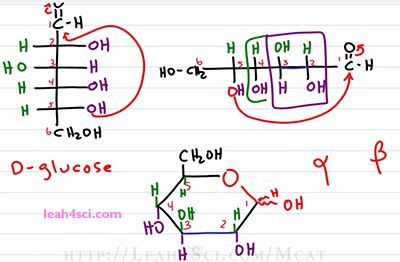
Attached to carbon 2 on the right we have carbon number 1, Carbon number 1 got attacked by the Oxygen from carbon number 5 so let's swap that out for a red Oxygen and show that over here. On the other side we have Carbon number 3 is attached to carbon 4, 4 is attached to 5, 5 is attached to the Oxygen which did the attack. Make it bigger so we can see where all the substituents go and add them in. For carbons 2 and 3 nothing's changed, we have an OH down on 2, Hydrogen down on 3, Hydrogen up on 2 and OH up on 3. Carbon is 4 is also the same but it's slightly off to the side. We have an OH going down and a Hydrogen going up. Carbon 1 can be up or down depending on Alpha or Beta. I like to think of them as follows; when I draw an Alpha, it goes down, it has a tail that goes down and kinda looks like a fish which is down on a sea. And then Beta has a really big head. The head goes up kind of like a bird that flies high so if we put the OH up, it'll be a beta glucose, if we put the OH down it'll be an Alpha or in this case an Alpha D-glucose. For the sake of keeping it generic, we'll put the OH out to the side meaning it's not up or down and I'll just put in a Hydrogen and I'm drawing this quickly a line to show it could be up or down but for this molecule, we don't care.
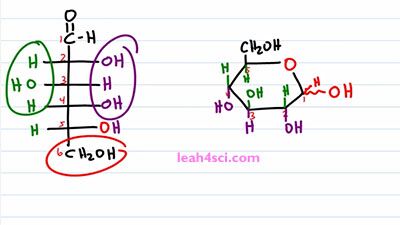
Carbon 5 is the tricky one. When I learned this in Biochem, we were taught that the molecules twist, so you have to look at the chirality this way in that way, and honestly it's too tedious to follow . So what I want you to think of is this; everything that we saw so far stay the same. We use the trick to drop the right down and the rest of left up. Right down, left up. For Carbon 6 which is attached to carbon 5, we're going to put 6 opposite where the OH was. The OH is on the right, meaning it would be dropped right down. And that means if CH2OH is opposite, that will be left up and that is CH2OH. And I want you to think of it this way rather than memorizing. With Beta D-glucose OH and the CH2OH are on the same side, Alpha D-glu goes CH2OH and OH are opposite. That Mnemonic works but if you're given a molecule that's a little different or for example not a glucose it gets confusing. But if you can look at the Fischer Projection and recognize that the CH2OH which is carbon 6 sitting on 5 is going to be opposite of where that OH was because it's twisted on the attack, you'll know if the OH would have been dropped right down the CH2OH stays up and that means default, the Hydrogen goes down.
This was a long and tedious method and on the MCAT you don't have time for this. You don't wanna draw it, you don't wanna waste that kind of time. So now let's use the same trick without re-writing it sideways, now let's look at how to go straight from the Fischer to the Haworth. So here we have D-glucose again and we're going to draw a 6-membered ring with an Oxygen up right. We then number so that carbons 2 and 3 are two forward most carbons that you see. One is towards the right and then just continue around the circle and then let's add the substituents. For carbons 2,3, and 4 we drop it right down. 2 gets an OH down, 3 gets an H, 4 gets an OH. For the other side, the green substituents are left up. Hydrogen up on 2, OH up on 3, Hydrogen up on 4. And carbon 6 goes opposite where the OH on Carbon 5 would have gone. The Oxygen on carbon 5 to be attacked that's in the ring. If the OH would have been dropped right down, the CH2OH gets left up. And that means we have a Hydrogen going down. Last but not the least see if a molecule asks for Alpha or Beta and then put your OH on carbon 1 accordingly with the Hydrogen opposite. If OH is up for Beta, Hydrogen is down, if OH is down for Alpha, Hydrogen is up. So that's the Haworth.
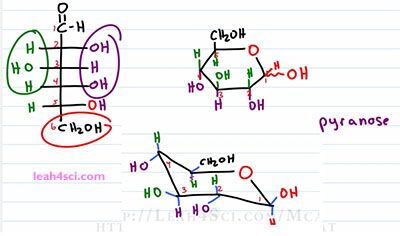
Now let's see how to turn this into a chair conformation. The first thing you have to is be very comfortable with chairs. I have detailed tutorial for this on my website, the link is on the description. But we'll do a quick overview here. We want to start with a basic chair skeleton. But because it's a sugar, we want an Oxygen here. I like to have the substituents go down from the Oxygen. That means here we have a parallel line, this side is the opening. Alright, that's the opening right there, so we have the carbon going down and on this side you have the carbon going up. The numbering works the same way, so you start at the Oxygen and then clockwise, we have 1,2,3,4,5. 6 will be our substituent and then just like with the Fischer to the Haworth, we're going to take the right side from 2 to 4 and drop it right down. But here you have to be careful because in a chair conformation you have your axial and equatorial substituents. So let's the skeleton lines first so we know where we have axials up and down and where we have equatorials up and down. And again this is covered in detail in my tutorial the links in the description.
So now we know where the pieces are going to go, let's fill them in. Carbons 2, 3, and 4 gets drop right down so the purple substituents on the right will go down. 2 gets an OH down which winds down equatorial, 3 gets a Hydrogen down winds up axial, 4 gets an OH down winds at equatorial. On the same carbons we have the green substituents that get left up so Hydrogen axial up on 2, OH equatorial up on 3, Hydrogen axial up on 4 and then carbon 6 is opposite of OH on 5. The OH would have been dropped right down so the CH2OH gets left up and look at that, it winds up equatorial which means we have a Hydrogen down. Now for the sake of this molecule let's show Beta E-glucose and the reason I'm showing this is this confirmation helps to understand why glucose is so stable in that cyclic form. In this molecule every single OH group including the CH2OH wind up equatorial making it very very stable and the tiny Hydrogen atoms are axial so you don't have many unfavorable diaxial interactions going on. Since these are 6-numbered rings, they're called pyranose and this represents a 6-membered ring sugar where it's not 6 carbons but instead it's heterocycle because you have an Oxygen on the ring. But what happens if you start with the molecule like the Fructose which gives you 5 numbered ring? D-fructose is a ketohexose that's because it's a ketone on a hex 6, ose sugar. Carbons 1 and 6 are both CH2OH and the carbonyl occurs at carbon 2 which is not chiral but we still show it on a Fischer Projection so that we can have the rest of the molecule flow the same way as we did with D-glucose which is an Isomer of the Fructose.
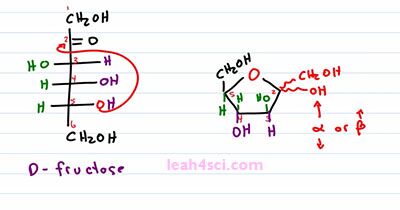
On D-Fructose, we only have 3-chiral carbons. Carbons 3, 4 and 5 and they follow the same pattern as Glucose. That's another reason I draw this on the right because it reminds me of the pattern. OH to the right, OH to the left, OH to the right and then D, it means the last one is OH to the right. Fill in the Hydrogens for the rest and that's D-Fructose. The trick for a 5-membered pyranose is the same as a 6-membered pyranose except we draw a 5 membered ring instead of 6. So we have 5 numbered ring with the Oxygen top and the numbering is also different. For this molecule we have 3 and 4, rather than 2 and 3 as the carbons that we look at. And the reaction here once again is the Oxygen on carbon 5 swinging around to attack the carbonyl on carbon 2. So the anomeric carbon here is carbon 2 and that's the one that can go up and down. Carbon 5 could be attacked so it's still attached to the Oxygen that attacked and Carbon 6 will come off at carbon 5. The only carbon that actually stay the same are 3 and 4. So 3 and 4 will be dropped down, that means we have a right, down, hydrogen on 3, a right down OH on 4. The other side gets left up so we have the OH up on 3, Hydrogen up on 4. Now what about the rest of the molecule? Just like with the pyranose, the CH2OH on Carbon 5 will be opposite where the OH was. If the OH would have been dropped right down, the CH2OH will be left up, and that means we have the Hydrogen going down and Carbon 2 will vary depending on if we get out for a beta depending on the direction of the attack.So in this case we'll just show a squiggly line but it's not just the OH that we're showing, we're also looking at the CH2OH coming off of that carbon. So one of the groups will be a CH2OH and the other group will be an OH where the OH is what tells you Alpha or Beta, where Alpha is down and beta is up and the CH2OH simply goes in the opposite direction.
That conclude the series on Fischer Projections. If you feel confident with the material make sure you try the practice quiz which you can find on my website along with this entire series and cheat sheet leah4sci.com/Fischer and don't forget to subscribe and to share this series with all your premed friends so that they to can learn this trick and save some time on their MCAT.
[End of Transcript]
Click HERE to Catch my entire video series on Fischer Projections.



Leave a Reply